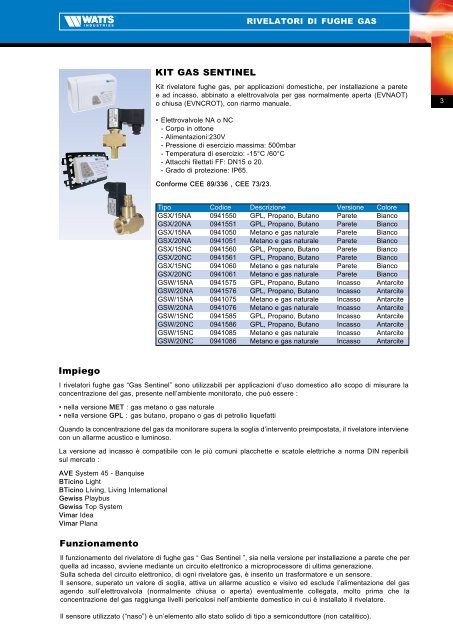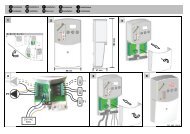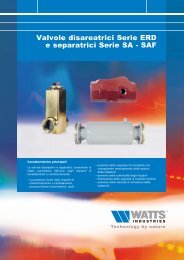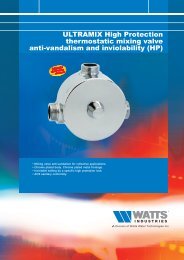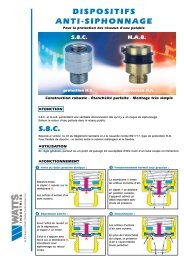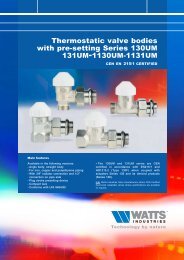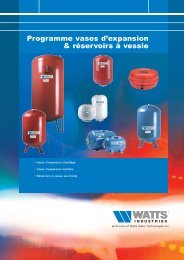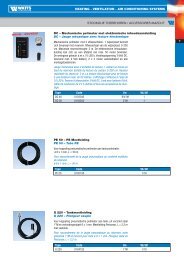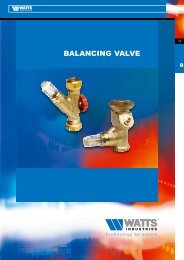GAS SENTINEL - Rivelatori di fughe gas Metano e ... - Watts Industries
GAS SENTINEL - Rivelatori di fughe gas Metano e ... - Watts Industries
GAS SENTINEL - Rivelatori di fughe gas Metano e ... - Watts Industries
Create successful ePaper yourself
Turn your PDF publications into a flip-book with our unique Google optimized e-Paper software.
RIVELATORI DI FUGHE <strong>GAS</strong><br />
KIT <strong>GAS</strong> <strong>SENTINEL</strong><br />
Kit rivelatore <strong>fughe</strong> <strong>gas</strong>, per applicazioni domestiche, per installazione a parete<br />
e ad incasso, abbinato a elettrovalvola per <strong>gas</strong> normalmente aperta (EVNAOT)<br />
o chiusa (EVNCROT), con riarmo manuale.<br />
3<br />
• Elettrovalvole NA o NC<br />
- Corpo in ottone<br />
- Alimentazioni:230V<br />
- Pressione <strong>di</strong> esercizio massima: 500mbar<br />
- Temperatura <strong>di</strong> esercizio: -15°C /60°C<br />
- Attacchi filettati FF: DN15 o 20.<br />
- Grado <strong>di</strong> protezione: IP65.<br />
Conforme CEE 89/336 , CEE 73/23.<br />
Tipo Co<strong>di</strong>ce Descrizione Versione Colore<br />
GSX/15NA 0941550 GPL, Propano, Butano Parete Bianco<br />
GSX/20NA 0941551 GPL, Propano, Butano Parete Bianco<br />
GSX/15NA 0941050 <strong>Metano</strong> e <strong>gas</strong> naturale Parete Bianco<br />
GSX/20NA 0941051 <strong>Metano</strong> e <strong>gas</strong> naturale Parete Bianco<br />
GSX/15NC 0941560 GPL, Propano, Butano Parete Bianco<br />
GSX/20NC 0941561 GPL, Propano, Butano Parete Bianco<br />
GSX/15NC 0941060 <strong>Metano</strong> e <strong>gas</strong> naturale Parete Bianco<br />
GSX/20NC 0941061 <strong>Metano</strong> e <strong>gas</strong> naturale Parete Bianco<br />
GSW/15NA 0941575 GPL, Propano, Butano Incasso Antarcite<br />
GSW/20NA 0941576 GPL, Propano, Butano Incasso Antarcite<br />
GSW/15NA 0941075 <strong>Metano</strong> e <strong>gas</strong> naturale Incasso Antarcite<br />
GSW/20NA 0941076 <strong>Metano</strong> e <strong>gas</strong> naturale Incasso Antarcite<br />
GSW/15NC 0941585 GPL, Propano, Butano Incasso Antarcite<br />
GSW/20NC 0941586 GPL, Propano, Butano Incasso Antarcite<br />
GSW/15NC 0941085 <strong>Metano</strong> e <strong>gas</strong> naturale Incasso Antarcite<br />
GSW/20NC 0941086 <strong>Metano</strong> e <strong>gas</strong> naturale Incasso Antarcite<br />
Impiego<br />
I rivelatori <strong>fughe</strong> <strong>gas</strong> “Gas Sentinel” sono utilizzabili per applicazioni d’uso domestico allo scopo <strong>di</strong> misurare la<br />
concentrazione del <strong>gas</strong>, presente nell’ambiente monitorato, che può essere :<br />
• nella versione MET : <strong>gas</strong> metano o <strong>gas</strong> naturale<br />
• nella versione GPL : <strong>gas</strong> butano, propano o <strong>gas</strong> <strong>di</strong> petrolio liquefatti<br />
Quando la concentrazione del <strong>gas</strong> da monitorare supera la soglia d’intervento preimpostata, il rivelatore interviene<br />
con un allarme acustico e luminoso.<br />
La versione ad incasso è compatibile con le più comuni placchette e scatole elettriche a norma DIN reperibili<br />
sul mercato :<br />
AVE System 45 - Banquise<br />
BTicino Light<br />
BTicino Living, Living International<br />
Gewiss Playbus<br />
Gewiss Top System<br />
Vimar Idea<br />
Vimar Plana<br />
Funzionamento<br />
Il funzionamento del rivelatore <strong>di</strong> <strong>fughe</strong> <strong>gas</strong> “ Gas Sentinel ”, sia nella versione per installazione a parete che per<br />
quella ad incasso, avviene me<strong>di</strong>ante un circuito elettronico a microprocessore <strong>di</strong> ultima generazione.<br />
Sulla scheda deI circuito elettronico, <strong>di</strong> ogni rivelatore <strong>gas</strong>, è inserito un trasformatore e un sensore.<br />
Il sensore, superato un valore <strong>di</strong> soglia, attiva un allarme acustico e visivo ed esclude l’alimentazione del <strong>gas</strong><br />
agendo sull’elettrovalvola (normalmente chiusa o aperta) eventualmente collegata, molto prima che la<br />
concentrazione del <strong>gas</strong> raggiunga livelli pericolosi nell’ambiente domestico in cui è installato il rivelatore.<br />
Il sensore utilizzato (“naso”) è un’elemento allo stato solido <strong>di</strong> tipo a semiconduttore (non catalitico).


